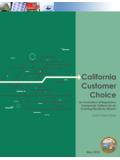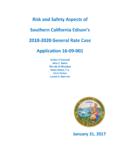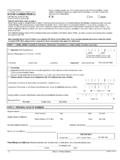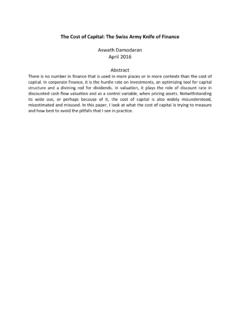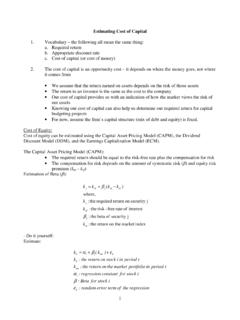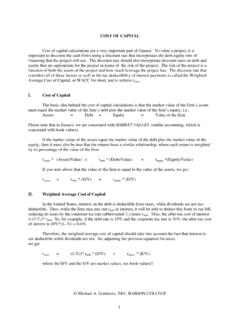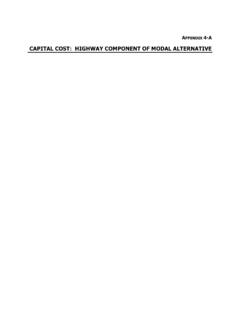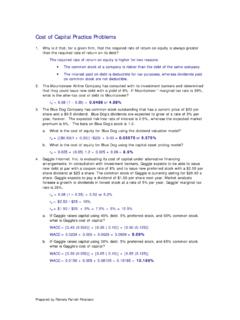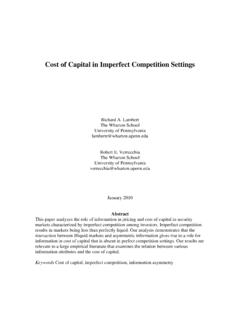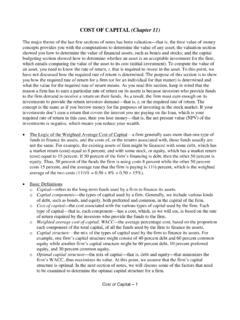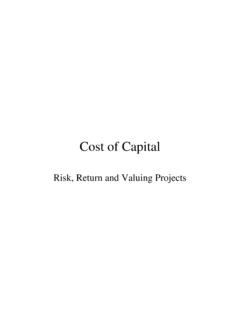Transcription of An Introduction to Utility Cost of Capital
1 1 An Introduction to Utility cost of Capital California Public Utilities Commission Policy & Planning Division Maryam Ghadessi Principal Author POLICY AND PLANNING DIVISION Marzia Zafar Director POLICY AND PLANNING DIVISION April 18, 2017 2 Contents I. Introduction .. 3 II. Legal standard for setting Return .. 3 III. Rate of Return .. 4 1. Capital Structure .. 5 2. Return to Debt and Preferred Stock .. 5 3. Return to Common Equity .. 6 a) Capital Asset Pricing Model (CAPM) .. 6 b) Discounted Cash Flow (DCF) Model .. 7 c) Risk Premium (RP) Model .. 7 4. Additional Risk Factors 8 IV.
2 California ROE compare to National Average .. 8 V. Authorized ROR vs. Recorded ROR .. 13 1. Recorded ROE vs. Authorized ROE .. 13 2. Recorded Capital Structure vs. Authorized Capital Structure .. 17 3. A Need to Focus on Recorded vs. Authorized ROR .. 19 DISCLAIMER This White Paper was prepared by California Public Utilities Commission (CPUC) staff. It does not necessarily represent the views of the CPUC, its Commissioners, or the State of California. The CPUC, the State of California, its employees, contractors, and subcontractors make no warrant express or implied, and assume no legal liability for the information in this White Paper.
3 This White Paper has not been approved or disapproved by the CPUC, nor has the CPUC passed upon the accuracy or adequacy of the information in this White Paper. 3 I. Introduction Utilities use long-term Capital to finance investment in physical plant and assets (asset base) needed to provide Utility service. Utilities also issue long-term Capital to finance the replacement and expansion of their facilities to fulfill public Utility service obligation. To finance investment in physical plant and assets utilities generally use long-term Capital such as bonds, preferred stocks, and common equity.
4 Investors expect to earn a return on their Capital . The Commission sets the authorized rate of return on Capital . Setting an authorized rate of return does not mean that the Utility is guaranteed to earn that rate of return. Rather, the authorized rate of return is merely a target estimate. The Commission sets retail prices sufficient to provide a reasonable opportunity for the Utility to earn its overall revenue requirement including that target return. Whether earnings actually meet or exceed the return depends upon actual operations. The Commission has the responsibility to authorize a return high enough to attract investors Capital and low enough to minimize ratepayer s costs.
5 The question is: What is a fair return that reasonably balances and optimizes these offsetting goals? This report discusses various factors that the Commission considers in establishing the authorized rate of return. In addition to explaining various factors considered in determining authorized rate of return, the report also provides recommendations for improving rate-of-return regulation in California. In particular, the comparison of the authorized return on equity in California to the national average calls for re-assessment of the cost of Capital Mechanism in California. The report also calls for examination of the divergence between recorded and authorized rate of return by showing the implications of that for revenue requirement.
6 The remainder of this report is divided into four parts. Section II discusses the legal standards for setting rate of return on Capital . Section III describes how Capital structure and component costs of Capital interact to determine the overall rate of return, or cost of Capital . Section IV contrast return on equity for utilities in California to the national average. Finally section V compares authorized rate of return to recorded rate of return. II. Legal standard for setting Return The legal standard for setting a fair rate of return has been established by the United States Supreme Court in the Bluefield and Hope That decision states that a public Utility should be provided an opportunity to earn a return necessary for it to provide Utility service.
7 The Court stated: The return should be reasonably sufficient to assure confidence in the financial soundness of the Utility , and should be adequate, under efficient and economical 1 Bluefield Water Works & Improvement Co. vs Public Service Commission of West Virginia (1923) 262 679. Federal Power Commission vs. Hope Natural Gas Co. (1944) 320 591. 4 management, to maintain and support its credit and enable it to raise money necessary for the proper discharge of its public duties. The Bluefield decision provides a lower bound requirement (at least enough to attract Capital ) than an upper bound requirement.
8 The Hope decision reinforces the Bluefield decision and in addition it provides an upper bound requirement. It emphasizes that such returns should be commensurate with returns available on alternate investments of comparable risks. The idea is based on the basic principal in finance that rational investors will only invest in a particular investment opportunity if the expected return on that opportunity is equal to the return investors expect to receive on alternative investments of comparable risk. The Hope decision states: The return to the equity owner should be commensurate with returns on investments in other enterprises having corresponding risks.
9 Two standards emerge from these decisions. First, return should be adequate to enable a Utility to attract investors to finance the replacement and expansion of a Utility s facilities to fulfill its public Utility service obligation. Second, to attract Capital a Utility should be able to offer returns to investors comparable to those achieved on alternative investments of comparable risk. In applying these standards the Commission strives not to lose sight of its duty to ratepayers to protect them from unreasonable risks including risks of imprudent management and strives to strike a balance between the interest of ratepayers and shareholders.
10 III. Rate of Return The overall rate of return (ROR) or cost of Capital from a ratemaking perspective is a weighted average cost of debt, preferred equity, and common equity, where the weights are the book-value percentages of debt, preferred equity, and common equity in a firm's Capital structure. ROR or cost of Capital , which is called the firm's weighted average cost of Capital (WACC), is specified by the following formula: WACC= wdkd+ wpkp+ wckc where, wd = % of debt in Capital structure, wc = % of equity in Capital structure, wp = % of preferred stock in Capital structure, kd = cost of debt, ks = cost of equity, and kp = cost of preferred stock.

